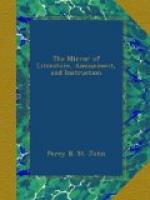“On one side of the court, a portal, richly adorned, opens into a lofty hall, paved with white marble, and called the Hall of the Two Sisters. A cupola, or lantern, admits a tempered light from above, and a free circulation of air. The lower part of the walls is encrusted with beautiful Moorish tiles, on some of which are emblazoned the escutcheons of the Moorish monarchs: the upper part is faced with the fine stucco-work invented at Damascus, consisting of large plates, cast in moulds, and artfully joined, so as to have the appearance of having been laboriously sculptured by the hand into light relievos and fanciful arabesques, intermingled with texts of the Koran, and poetical inscriptions in Arabian and Cufic character. These decorations of the walls and cupolas are richly gilded, and the interstices pencilled with lapis-lazuli, and other brilliant and enduring colours. On each side of the hall are recesses for ottomans and couches. Above the inner porch is a balcony, which communicated with the women’s apartments. The latticed ‘jalousies’ still remain, from whence the dark-eyed beauties of the haram might gaze unseen upon the entertainments of the hall below.
“It is impossible to contemplate this once favourite abode of Oriental manners without feeling the early associations of Arabian romance, and almost expecting to see the white arm of some mysterious princess beckoning from the balcony, or some dark eye sparkling through the lattice. The abode of beauty is here, as if it had been inhabited but yesterday; but where are the Zoraydas and Lindaraxas?
“On the opposite side of the Court of Lions, is the Hall of the Abencerrages; so called from the gallant cavaliers of that illustrious line who were here perfidiously massacred. There are some who doubt the whole truth of this story; but our humble attendant Mateo pointed out the very wicket of the portal through which they are said to have been introduced, one by one, and the white marble fountain in the centre of the hall where they were beheaded. He showed us also certain broad ruddy stains in the pavement, traces of their blood, which, according to popular belief, can never be effaced. Finding we listened to him with easy faith, he added, that there was often




